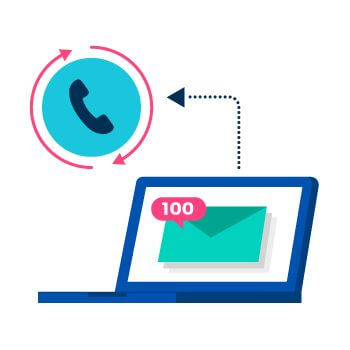Main Differences Between a SDR & Account Executive

Contents
Up until a few decades ago, most companies only had two types of sales positions – inside sales and outside sales.
While the inside reps hammered the phones and sent letters, the outside team would knock on doors, go to meetings, and attend events.
Each was important to the success of the business and had its own integral part of the sales process.
Fast forward to the current day and things have become even more specialized. Today, sales functions rely on multiple highly specific roles for all sorts of tasks. A typical sales organization might have business development representatives, sales development representatives (SDRs), sales executives, account executives, and more.
In this guide, we’ll cover what the role of SDR & Account Executive entails. Plus the key skills needed to be successful in either position and tips for landing the job.
What Is a Sales Development Representative?
 At the start of the business year, companies set their strategic goals.
At the start of the business year, companies set their strategic goals.
Often, they will do the math on all the smaller targets that need to be achieved in order to hit their overarching objective.
For instance, to hit $X million in revenue, they need to retain Y% of their current client base, while closing Z new deals a month.
Those more granular targets directly impact the sales development representative, who has ultimate responsibility for outbound prospecting.
SDRs can sit within the sales or marketing teams, but more often than not, they report to managers within the sales function. It’s up to them to generate enough leads to hit those X new deals a month, bearing in mind the company’s average conversion rate of leads to sales.
Once targets have been identified and broken down into smaller, team-level goals, sales development representatives begin the task of cold prospecting via email and phone.
They might reach out to dozens – or even hundreds – of people in an average day in the hope of striking up a conversation and moving prospects down the sales funnel.
To be successful in the role, sales development representative must become specialist educators, using their product and industry knowledge to help potential customers solve real-world business problems.
What Is the Role of a Sales Development Representative?
 In the SDR game, volume of activity is everything. Generally speaking, the more (effective) calls you make and emails you send, the more prospects you’ll turn into leads.
In the SDR game, volume of activity is everything. Generally speaking, the more (effective) calls you make and emails you send, the more prospects you’ll turn into leads.
With that in mind, most sales development representatives have pretty regimented and consistent workloads. A typical day in the life might look like this:
- Check the calendar for appointments that day
- Check email to see if any prospects responded or engaged with their email
- Check voicemail to see if they got any callbacks
- Attend the daily standup
- Check social media for direct messages and engagement
- Begin cold prospecting with outbound calls and emails
- Attend sales meetings
- Send follow-ups or connection requests via social media
- Check activity and performance logs for the team
- Have one-to-one review with manager
- More cold prospecting with outbound calls and emails
What Is an Account Executive?
An account executive’s primary responsibility is to support an organization’s client accounts. They’re generally the first or second person within an organization to handle the account, possibly after the front-line sales rep.
They’re often responsible for closing deals once a lead has been qualified and nurtured by a lower-level salesperson.
Once they’ve made contact, it’s up to the account executive to manage that account by:
- Building the relationship
- Identifying up-sell and cross-sell opportunities
- Handling contract renewals
What Does an Account Executive Do?
As I mentioned before, an account executive isn’t a traditional “executive” in that they don’t usually manage a big team or report to the board.
Instead, they play a leading role in establishing and developing client relationships. However, the specifics of the role can vary depending on the organization:
- In some organizations, the account executive is the person who actually finalizes a sale with a prospect.
- In others, they may be responsible for identifying new prospects, and potentially for guiding those prospects through the whole sales process.
- Alternatively, they may get involved immediately after the deal has been closed, helping to onboard the new client and identifying upsell possibilities down the line.
While they spend most of their time working directly with clients, account executives may also communicate with account managers, sharing relevant information that will help the account managers take control of the account.
What Are an Account Executive’s Main Tasks & Responsibilities?
Given that their role in the sales process varies from one organization to another, an account executive’s roles and responsibilities can also be pretty wide-ranging.
However, they’ll typically include things like:
- Identifying potential target accounts through online and offline networking.
- Creating (and potentially delivering) effective sales presentations and pitches.
- Building and nurturing client relationships.
- Hitting sales targets.
- Resolving client issues and queries that crop up before the deal has closed.
- Seeking out opportunities to upsell and cross-sell existing accounts.
- Understanding and satisfying client needs and challenges.
- Finding key trends through data analysis.
- Handling negotiations and overcoming potential concerns.
- Staying up to date on industry trends and company products/solutions.
Account Executive vs. Account Manager: What’s the Difference?
The distinction between these roles isn’t always straightforward, especially considering that some organizations merge them into one position.
On the surface, the account executive and account manager roles are pretty similar: they both work directly with clients, and they’re both about building stronger relationships.
However, while the overarching end goal – delivering more revenue for the business – is the same, their key focuses are quite different.
Account executives typically get involved much earlier in the process than account managers. They may be the first person to make contact with a new account, guiding the prospect down the sales funnel until they’re ready to convert, and potentially closing the deal themselves.
By contrast, account managers don’t get involved until after the contract has been signed.
At this point, the prospect has become a full-fledged customer, and the account manager steps in to manage the relationship – hopefully for the long term.
However, there may still be some overlap between the two roles even after the account manager has stepped in. For instance, the account executive might be involved throughout the onboarding process, and may take the lead on initial upselling and cross-selling opportunities.
What Skills Does an Account Executive Need?
We’ve established that an account executive’s responsibilities can vary widely, so it’s not surprising that to thrive in the role, an account executive must hone a wide range of skills and characteristics. Some of the most important include:
- Communication: This is fundamental. You’ll constantly be in contact with different prospects, leads, and accounts, all of whom will have their own communications preferences. You’ll need to adapt your comms accordingly.
- Empathy: Can you put yourself in the prospect’s shoes? Do you understand the pain points they’re feeling and their desire to resolve them? If so, you’re more likely to foster strong relationships.
- Problem-solving: You’ll come across a bunch of problems in any given day. To maintain momentum on a sale, you can’t always afford to spend a week planning your response or talking through the issues with your manager.
- Organization: The average account executive’s day can be pretty intense, involving a lot of different activities, so you need to be organized and manage your time effectively.
- Negotiation: Leading negotiations is a skill in itself. You need to identify objections before they arise and come up with ways to resolve them, while still landing the best possible deal for your organization. It’s not just about giving the client everything they want.
- Determination: An account executive needs to be determined to get results. It’s all about seeing the end goal and focusing on reaching it.
Overall, just like any other sales role, account executives need to be prepared to put in the hours in order to stay competitive and get results.
The Top 5 Skills Every Sales Development Representative Needs
Not everyone is cut out for the life of a sales development rep.
It’s a fast-paced, high-pressure role – after all, if the SDRs aren’t doing their job, the company isn’t generating enough leads, which means it won’t close enough deals or hit its revenue targets.
To make it as an SDR, you need these five skills:
1. Curiosity
A good SDR has the energy to keep sending emails and making calls, all day, every day.
But a great SDR does it all with a sense of curiosity. They’re not just hitting their activity targets; they’re genuinely eager to learn more about the wider industry in which they work, the competition they’re up against, and the customers they’re speaking to day in, day out.
That thirst for knowledge helps them build confidence on the phone and gain the trust of the people they speak to, which in turn helps them turn more prospects into qualified leads.
As such, the best SDRs are constantly asking questions like:
- Why would someone buy our product rather than our competitor’s?
- What’s the best way for me to get a prospect bought in from the very start of a call?
- Which types of prospects am I best at speaking to?
- How can I get better at speaking to other types of prospects?
2. Empathy
For SDRs, gaining the trust of their prospects goes a long way toward converting them into leads.
Empathy is a vital skill when it comes to building trust, enabling reps to demonstrate that they care more about the prospect’s business challenge than they do about closing the deal.
Of course, anyone can claim to be empathetic, but actually doing it is another thing entirely.
Empathetic SDRs listen more than they talk. That way, they can truly absorb what the prospect is telling them.
Repeat what the prospect has just said so they’re sure you understand things from their perspective, and don’t be afraid to keep on asking questions until you get to the root cause of a problem, not just the symptoms.
3. Product Knowledge
Naturally, you need to know about your industry, competitors, and customers. But it counts for little if you can’t also answer basic questions about your own product.
If your product doesn’t change too much, there’s simply no excuse not to know it inside out.
If it’s more complex, you still need a basic understanding of it – and you also need to know who you can turn to for more advanced assistance during the demo process. Sales engineers can be your biggest allies at this stage.
4. Objection Handling Skills
Arguably the most difficult part of the SDR role is handling objections.
Why? Because you simply don’t know what your prospects are going to say, and if you don’t respond in a convincing manner, you could sink the whole deal.
However, it’s important to note that there are only so many objections. Most will revolve around common themes like price and timelines. Write down every objection you hear and craft a persuasive response that you can repeat next time you encounter it.
When it comes to planning a reply, focus on helping prospects recognize the challenges they’re facing and how your product can mitigate them. For instance:
- Objection: We don’t have budget for that right now.
- Response: We have a customer with a similar issue to yours. When they bought our product, they actually saved $X through efficiencies.
- Objection: Company Y sells a similar product to yours, but for much cheaper.
- Response: Company Y’s product doesn’t have this specific feature. I believe that this specific feature would have a big impact on your business.
5. Relentlessness
Even exceptional SDRs will hear “no” a lot more than “yes”. It comes with the territory of cold outreach.
What separates the best from the also-rans is their ability to dust themselves down and immediately pick up the phone or write another email.
How do you do that? By embracing rejection.
Keep in mind that every “no” you hear gets you another step closer to that all-important “yes”.
Also, consider that a lot of prospects simply aren’t in a position to buy. The sooner you can disqualify them from your process and move on, the better.
According to research, SDR’s hired today have only 1.4 years of experience. In 2010 it was 2.5 years.
Tips for Landing an Account Executive Job
Like with most jobs, there’s no universal approach to getting a role as an account executive. You absolutely need to adapt to the organization you’re applying for.
Given the wide range of account executive roles and responsibilities, it’s important that you closely scrutinize the job specification to ensure that you understand exactly what is expected. If anything is unclear, don’t be afraid to ask the recruiter or hiring manager before you apply.
Similarly, company culture is an important consideration. Some organizations are more casual, while others are much more formal, so you’ll always want to adapt your tone to match theirs.
Beyond those general pointers, here are some more specific do’s and don’ts to consider when applying for an account exec job:
Do:
- Use real-world examples: When it comes to discussing your experience, show, don’t tell. In other words, don’t just tell them how great you are at communicating, or how brilliant you are at nurturing relationships – give practical examples of when you’ve put those skills into practice in the past.
- Practice common sales interview questions: You should be able to anticipate the majority of questions you’ll be asked. These may include: Can you talk me through your sales experience? Why did you choose a career in sales? What’s a mistake you’ve made, and what did you learn from it? Prepare answers and go over them several times.
- Speak with confidence: Interviews can be nerve-wracking, but this is a sales job. If you can’t get your point across clearly and with confidence, that doesn’t inspire much faith that you’ll be able to get results in the “real world.”
- Ask questions yourself: You want to demonstrate that you’re interested in this specific role, not just looking for any job as an account executive. One of the best ways to do that is by asking questions about the job. What do the progression opportunities look like? What training can you expect to receive? What are the biggest challenges you’ll face?
Don’t:
- Leave anything to chance: You might be a naturally confident person, but don’t expect your charm and improvisational ability to get you the job. Sales isn’t all about talking a good game – you need to work hard, too. So don’t go in under-prepared.
- Be late to phone, video, or in-person interviews: If you got the job, a client likely wouldn’t appreciate you turning up late to a pre-arranged meeting. So it sets a bad precedent if you arrive late for an interview.
- Just talk about yourself: Sales isn’t a one-way conversation. You build rapport by striking up back-and-forth discussions with prospects. So don’t be afraid to do the same during the recruitment process.
Tips on How to Become a Successful Sales Development Representative
 The SDR role is very process-driven. That means if you’ve got the innate skills required for the job, there are tried-and-trusted ways to level up your performance. For instance:
The SDR role is very process-driven. That means if you’ve got the innate skills required for the job, there are tried-and-trusted ways to level up your performance. For instance:
- Find yourself a mentor. Someone with the experience to help you solve problems and learn from your mistakes.
- Dissect the habits and talk tracks of the best SDRs at your company. Pick out what works for them and apply it to your own conversations with prospects.
- Read sales books and expand your knowledge. Broadening your horizons and embracing new ways of thinking can help you become a better-rounded salesperson.
- Be candid with your prospects. Gain their trust by being upfront about the limitations of your product and also what it does well.
How to Get Promoted from SDR to Account Executive
Getting promoted in today’s world is far from a straightforward process. Few of us have jobs that have a clear linear path and specific milestones to accomplish before we automatically get promoted. And making the transition from sales development rep (SDR) to full-fledged account executive (AE) is no different. Sure, moving from SDR to AE is the logical progression, but it’s not a step that everyone can – or should – take.
If your goal is to become an AE, what do you need to know to successfully make the transition? The end all be all of being promoted to account executive from the SDR role comes down to absolutely crushing your numbers. Not just one time – but every time. Every month. Every quarter. If you can hit goal consistently as an SDR then you can safely bet you will be the front runner the next time any account executive opportunity presents itself.
You may also want to consider going to another company. Research by LinkedIn shows that people are job-hopping more than ever, and sometimes it’s the quickest path to the position you truly want. Try leveraging your LinkedIn profile by making it accessible to recruiters reaching out, or actively pursue opportunities you find online.





